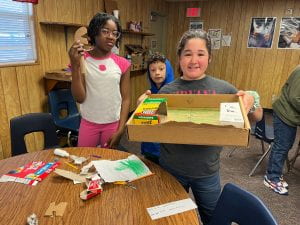Introduction
Makerspaces have become popular in education, providing hands-on learning opportunities that foster creativity, problem-solving, and collaboration. At Robertson Elementary, we believe in hands-on learning adventures that spark curiosity and creativity. Recently, our 5th-grade students embarked on an exciting journey within our makerspace, using only cardboard and basic materials to bring their imaginations to life.
Setting the Stage
The classroom buzzed with anticipation as students gathered around tables filled with cardboard, scissors, tape, and markers. Each group was tasked with designing and building a unique structure using only cardboard and basic materials.
The Challenge Begins
Students brainstormed ideas, considering concepts from their math curriculum such as geometry, measurement, and spatial reasoning. Our young innovators brainstormed ideas, exploring concepts from their math lessons. They played with shapes like squares, rectangles, triangles, and circles, turning them into sturdy bases and walls for their structures. Measurement skills were put to the test as students carefully cut pieces of cardboard to precise lengths, ensuring a snug fit for their structures.
Math TEKS Connection
Without even realizing it, our students were diving deep into math concepts! They learned about shapes and their properties, understanding angles, corners, and sides. Building their creations required them to think in three dimensions, visualizing how different pieces of cardboard fit together to form a solid structure.
Geometry (TEKS 5.6) Measurement (TEKS 5.4) Spatial Reasoning (TEKS 5.8)
Collaborative Learning
As the challenge progressed, students collaborated with peers, offering suggestions and sharing resources to overcome obstacles. Collaboration was key as students shared ideas and helped each other tackle challenges. Together, they discovered new techniques and ways to reinforce their structures, learning from one another along the way.
Reflection and Evaluation
After completing their cardboard creations, students reflected on the process, identifying successes and areas for improvement. They discussed how mathematical concepts were applied in practical ways throughout the challenge, deepening their understanding of math in real-world contexts.
Conclusion
Through initiatives like the cardboard challenge, we aim to show our children that math is everywhere, even in something as simple as cardboard. By making math fun and practical, we’re helping them develop essential skills for success in school and beyond. Our cardboard challenge wasn’t just about building structures—it was about building confidence, creativity, and a love for math. As parents and educators, let’s continue to find exciting ways to inspire our children’s curiosity and nurture their passion for learning. Together, we can empower them to reach new heights of imagination and achievement.

 Robertson Elementary School
Robertson Elementary School